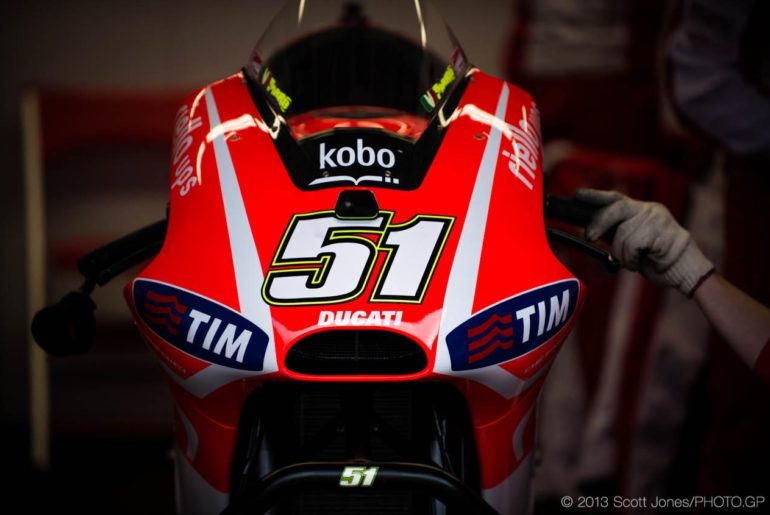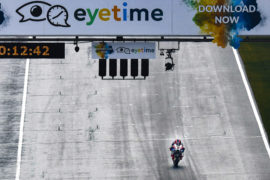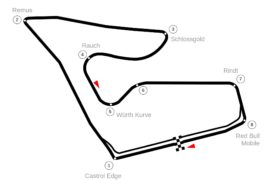In the final part of our series on test riders, (see also Part 1, with Mike Leitner, Part 2, with Davide Brivio, and Part 3, with Davide Tardozzi) an interview with Michele Pirro, Ducati’s workhorse and arguably the rider responsible for taking the concept of a test rider to a higher level.
Pirro’s path to Ducati ran through the CRT bikes, spending a year on a Honda-powered FTR bike with the San Carlo Gresini team in 2012, after graduating from Moto2.
In 2013, he was hired by Ducati to work as a test rider under Bernhard Gobmeier, who was brought in as head of Ducati Corse, after the Italian factory had been bought by Audi.
A year later, when Gigi Dall’Igna took over as Ducati Corse boss, Pirro was given even more responsibility in helping to turn the program around, which had lost its way in the years after Casey Stoner left Borgo Panigale.
Since then, Pirro has been charged with pushing forward the development of the bike. Pirro’s speed has been key to helping the Desmosedici improve, the Italian consistently capable of running in or around the top ten.
His best finish last year came at Misano, where he crossed the line in fifth, equaling his best result in MotoGP. Wildcards are just one way in which Pirro remains fast, he also races in the Italian CIV championship, which he wins with relative ease.
But his dream remains to return to MotoGP, and to have a shot at proving he is not just a great test rider, but a great MotoGP racer.
Andrea Dovizioso, who came to Ducati at the same time as Pirro, is clear about his importance as a test rider. “His work about test the rider is amazing, because he’s able to make a similar lap time, so we are very lucky to be in this condition. He is testing a lot.”
I spoke to Pirro at the 2018 Sepang test, on a day he was not testing the GP18. Pirro was very open about his aims and goals, and also about the process that had brought him to where he is today, and about the development he has engaged in for Ducati.
Q: You’re not riding today. Do you wish you were out there right now?
MP: Now it’s OK. My roots, in the beginning when I started [in 2013], when I came to Ducati, only the first year I was riding to test the MotoGP, but normally, in the second year I would race all season.
But it was very difficult, especially after Valentino [Rossi], the bike is not fast, there were many problems. And after one year, Gigi came, and started a new era, a new system for working.
So Gigi spoke with me to continue this route as a test rider and some wildcard races, and as a replacement rider if a rider crashed.
For sure, for me it’s not so easy, because my mentality is as a racer. And when I raced, the results were good. This for me is good, but when I’m not racing, I’m very angry, because my level is high.
But OK, I’m happy, because the bike improved with me, with Dovi, because Dovi came to Ducati with me, and now every year, the bike is very consistent, and this is very important for my job.
Q: So you feel pride seeing results of other riders racing the bike you helped make?
MP: It’s clear. People don’t understand the real situation. But we do a big job, the people inside Ducati and the test team, because it’s the first time that the new parts arrive in the track, the first time I’m using them, and the people of the test team.
When the bike is OK, it’s possible for the official riders to try them. But in any case, my speed is like the official riders. This is important, because in this case, the old bike and the new bike are different, the difference is very small, but if you don’t push at the limit, this is difficult to understand.
Because it’s maybe only less than one tenth that the bike is better or not better, but if the lap time was not fast, if you lose three or four seconds, you don’t understand if it’s better.
Q: You can’t understand the limit if you are 2 seconds slower?
MP: Exactly.
Q: How do you keep so fast, when you are not racing?
MP: My ambition is to go fast every time, to improve my riding style, my speed. Because my ambition is to race one season in one team for a whole season, and try to go fast in all situations, in the same team, same bike, same people.
Not change every race, every time. Now I think my situation, I have been for many years in MotoGP, I understand the electronics, the chassis, understand very well the whole package, but never in the last three or four years could I try for one complete season with one bike to improve my speed, to only work on my speed.
When I’m riding the bike normally, the conditions are always changing. Because OK, one time I’m testing, one time I’m racing. One time I’m testing different parts.
One time I’m testing with Pirelli, with the Panigale, with the V4. So it’s impossible to find the last three or four tenths, because I don’t have time to understand very well the limit.
Q: Because you are always on something completely different?
MP: This is important, because my limit is very high, but I don’t know if it’s possible to reduce this gap, this three or four tenths, if I stay one complete season or two or three months using the same bike, the same tires. I don’t know. But I never tried. But I hope in the future this possibility is realized.
Q: But some teams must sometimes ask you to ride for them, do Ducati have to persuade you to stay?
MP: When I speak, OK, but I think that the situation is not so easy. So last year, we arrived very close to winning the championship with Dovi, but two years ago the situation was not so easy.
But now for sure, I like riding the Ducati, because it’s fast, not many problems, this makes me happy. But my alternative in this moment doesn’t exist…. [laughs]
Q: Do you think that teams don’t understand your speed enough because you are not racing very often?
MP: I think the data is very clear. The data, especially when I have the opportunity to compare with other riders, when it’s possible to check the real situation. And I think that the team knows the real situation.
But for sure if I don’t have another opportunity to change my position, it’s difficult. Because normally, if like Iannone two years ago, his crash in Misano, and it wasn’t possible for him to race for two races, and I’m racing and finishing two times, maybe sixth and tenth in Aragon.
Because of these points, it’s possible to arrive top three in the team championship. For sure, it’s important to have three fast riders normally.
OK, I’m a test rider, but I don’t like this name. I think that if now if I can stay on track all of the races, it’s possible for me to stay in the top five or top ten, because every race, my position in practice is top five, top six, and in the race, top ten every time.
This is very important, because I only race three races in one year.
Q: Your motivation during a test is then to go fast and prove you deserve a ride?
MP: This is the key of my improving. Every test, every session, when I’m alone in the track, but my brain, the focus is go faster. Go faster, because when I’m racing, it’s possible to keep the gap not too big, the difference not too big.
Because if you don’t push at the maximum in the test, when I arrive in the race weekend, you are not ready.
Q: But it must be more difficult to go fast when you are on track alone, without a target to chase?
MP: Yes, it’s clear. But for sure you have the data. You have the data to compare to the past, the lap time or the data of a computer simulation. But normally, the motivation of a weekend of racing is much easier. Because when you are riding alone, it’s not the same, not the same situation.
Q: Is it enjoyable to ride a bike so fast, or is it racing that you need?
MP: For me, if I stop racing, my level will go down. This is important. My next race is in May, my next race in a normal situation. Now it’s January. If you don’t think you have an objective in May to go fast to aim at a top five or the top level, the motivation goes down. If you’re only a test rider, I think it’s impossible.
Normally, I’m called many times by other companies, but if I feel it’s not fast or it’s not possible to race, it’s not possible to go to another company, because I would be only a test rider like Colin [Edwards]. But I am young, it’s possible for me to race still. I’m available. This is very important.
Q: Did it help when you were racing in the Italian championship?
MP: Normally for sure, the training when I stay at home, it’s important to train, because if you are not training, it’s impossible to ride the MotoGP bike. Normally it’s not more than one test in one month, and one test is two or three days.
But two or three days it’s impossible to be fast, considering my first race is in May. To arrive in Mugello with ten days on the bike is not too much. OK, it’s possible to go training with motocross, with Supermoto, but racing, the races like the CIV are the best combination.
But it’s more difficult for me, because this bike, I never use it compared to the MotoGP. I only use it in the race weekend. And on the MotoGP I make many kilometers.
When I arrive at the CIV races, I’m the reference for these people. And for sure, these people training with this bike with these tires, and for sure, when I get on the bike, the first three or four laps, it feels like the bike is broken, the brakes don’t work, the tire is too soft, the chassis is not possible to change a lot… Just focus to stay on the bike and keep the improvement.
Q: Tardozzi said your comments are very precise and accurate. That seems very important. Is that a skill you can learn?
MP: It’s very important to understand, or know very well the bike. And I like this, because I go to the Ducati factory one day a week when I’m at home, because I live very close. It’s interesting to understand and work with the engineers.
Because for sure the confidence when riding the bike and the situation of checking the data, it’s impossible to compare the feeling to the data.
This is work that we all do together, because if the engineers don’t understand the rider, and the rider doesn’t understand the engineers, it’s difficult to find the good compromise, especially at this level.
And my comments are very very close or similar to the official riders. This is very important, because the work is very fast to keep the right direction. But in general, my comments are very simple. Very simple, but normally the engineers, the language of the engineers is completely different.
Q: Is it easier for the engineers to understand if your comments are simple?
MP: Yes, but sometimes my feeling or my sensation, you can’t see that in the data, because it’s the feeling you have with the asphalt, with the tire, chassis, suspension.
Q: So everything looks good on the data, but you are just feeling it’s bad?
MP: Maybe when I go in the corner, and it feels like you are going to lose the front a little bit, it’s difficult to see in the data. The engineers say, “there’s no problem with the bike”, but you won’t push because the feeling is not so good.
Q: You can go faster in theory, but you don’t because it doesn’t feel right?
MP: Because the data is the same for all rider. Maybe the lap time is 2’00, but many people with the same bike can do the same time, but not with the same setting, or the same configuration.
Because now Lorenzo is 1’58.8, and Dovi is close, but if you see the bike of Dovi and the bike of Lorenzo, they are completely different. But if you give Dovi’s bike to Lorenzo, the lap time is not the same.
Q: Do you have to test the settings of a rider, of Dovi or Lorenzo?
MP: Yes, many times. Many times I tried two different settings, because I have to test the difference, and normally it depends on the adaptation to the bike, maybe how you use the body.
My problem is this, not one season completely on the same bike. Always using Dovi settings, then Pirro settings, then Lorenzo settings. But I’m happy, because my speed improves, and this is important, because Ducati helped me a lot.
And thank you so much to Ducati, because I have this great opportunity to improve my speed, and I learned so much about the situation of the bike, of electronics.
Q: You don’t have any engineering knowledge, but you have a racer’s understanding?
MP: I only explain my feeling, my option, but at school, I wasn’t fantastic, because I didn’t like to write…
Photo: © 2013 Scott Jones / Photo.GP – All Rights Reserved
This article was originally published on MotoMatters, and is republished here on Asphalt & Rubber with permission by the author.




